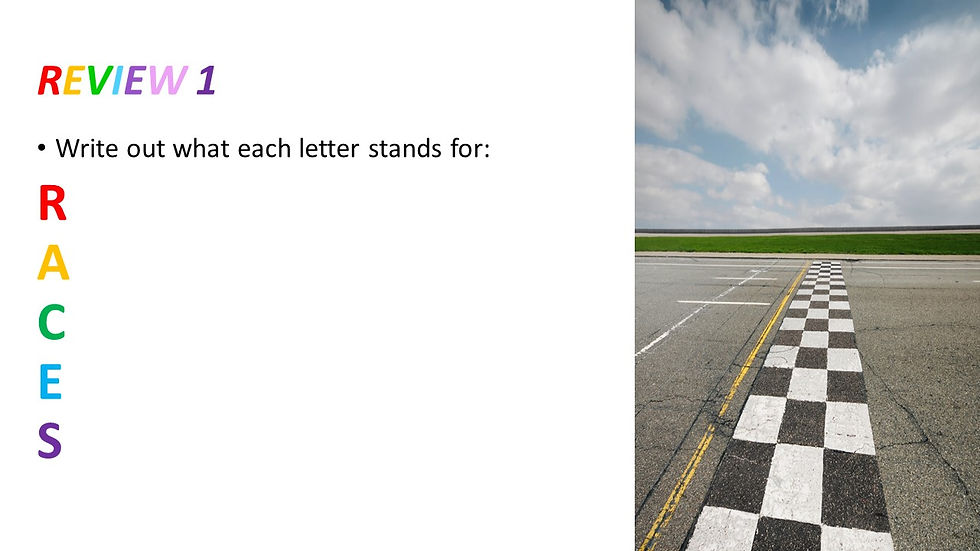R.A.C.E.S. Method
Today, I want to talk about how you can write very organized paragraphs by using the R.A.C.E.S. method.

What is the R.A.C.E.S. method?
It is a strategy to write organized paragraphs and it is used for paragraph response questions.
Let's take a look at what the acronym R.A.C.E.S. stands for:
R - Restate Key Words

The letter "R" stands for Restate Key Words. One of my students said, "I like restating key words, because it's really the key words within the question that we want to put in our first sentence." The example below is what it will look like:

Here, the question is: "What led to the fall of the Western Roman Empire?" The restatement will take some of those words and put them at the beginning of the sentence --The Western Roman Empire fell. Did you notice that we've changed the form of the word "fall" to "fell"? And we have changed the order and haven't used all of the words. Some students get confused and think that the restatement is simply writing out the question again, but it's not. We're changing the question into the start of an answer.
A - Answer the Question

"A" stands for Answer the Question. Here we want to provide a clear answer that gets right to the point. You can put it in the same sentence as the restatement.

For instance, we might write something like this: "The Western Roman Empire fell in part because of economic turmoil within the empire." You might want to write a first draft and then a second draft before you commit to using this in your paragraph.
C - Cite Evidence

"C" is for Cite Evidence. Now that we have our answer, we have to prove that the answer is true. We want to provide evidence to support it. We're going to take evidence from the text or texts that you're working with, and evidence can be stated in your own words that would be called paraphrasing or it could be a direct quote. If you're using a direct quote, you need to introduce the quotation. In both cases, especially at higher levels of writing, you need to cite the source or show where the source came from.

In this case, we can start the Cite Evidence section with something like "For instance". Note that in the example above, I have used MLA citations to show where this information came from and I also used that for the paraphrase.
E - Explain the Evidence

The next letter stands for Explain the Evidence. Here is where we want to clarify how the evidence supports our answer. We don't want to just make the evidence say it in another way, but we want to continue to develop the paragraph.

In the example above, I state "In other words, because of high expenses, Roman leaders levied high taxes on their citizens." And then I'm showing the effect of this-- "This in turn led to further economic problems and political instability as some citizens evaded taxation and sought independence within the empire."
S - Sum It Up

The last letter stands for Sum It Up. This is where you are going to restate your answer in a new way and bring the paragraph to a close.

You'll see here that in the first sentence, I wrote, "The Western Roman Empire fell in part because of the failing economy." In the last sentence, I expanded upon what I meant by "in part". So I said "While there were many factors that contributed to Rome's fall, economic failure played a major role in the decline of the empire." So I've come at it from a fresh angle here and that's what you want to do as well. Don't just change the order but try to express your answer in a fresh or new way.
Pro Tip

Signal phrases are some ways that we can transition easily between the different parts of R.A.C.E.S. When we cite evidence, we can use "for instance", "according to the text", or "for example" and there are many others as well. Explanation can be signaled by phrases like "this shows" or "in other words". Summing it up can be signaled through "in sum", "in short" and many others as well.
Let's Review!

Think about what each letter of R.A.C.E.S. stands for. Write it down on a piece of paper.

In Review 2, take a moment to think through each part of R.A.C.E.S. in this paragraph.


Comments